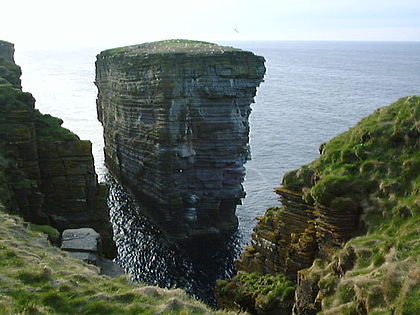 |
|

Best viewed in
|
Clett Rock is a solitary sea stack off Holborn Head on the Pentland Firth near Thurso. Its top is covered with grass and the ledges down the sides are home to a great number of sea birds. The rock is about 30 meters high, made of Caithness old red sandstone and separated from the mainland by a 15-meter-wide channel. As coastal headlands erode at different rates, this leads to some very unusual and striking rock formations. A sea stack is an isolated pinnacle of rock entirely surrounded by the sea at high tide. The beauty of sea stacks makes them popular subjects for photographers and painters, as well as providing nesting locations for seabirds, and many are popular for rock climbing. A flat-topped stack is usually called a clett, as here at Holborn Head but if its summit has a larger diameter than its height, then it is an island. Thurso is situated in the historical area of Caithness, it is the northernmost town on the British mainland. Thurso functioned as an important Norse port, and later traded with ports throughout northern Europe until the 19th century. A thriving fishing center, Thurso also had a reputation for its linen-cloth and tanning activities. Originally Thurso was known by the Celtic name of tarvodubron meaning "bull water" or "bull river"; similarly Dunnet Head was tarvedunum standing for "bull fort" and the name of the town name may have its roots there. Norse influence altered its name to Thjorsá, then Thorsá, based on the deity of Thor and translating as the place on Thor’s River. The local Scots name, Thursa, derives from the Norse, as does the modern Scottish Gaelic Inbhir Thẹrsa. Inbhir means a river mouth, and is generally found as "Inver" in many anglicized names.
|

